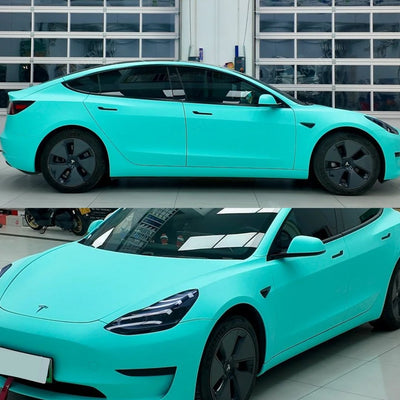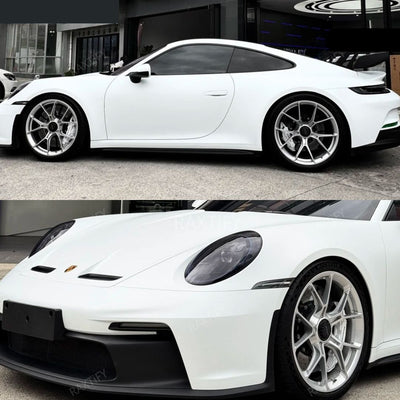
Introduction
Whenever you think of giving your car a new shiny new appearance through a vinyl wrap, the first thing that would come to your mind is: how much of your car will I have to wrap in vinyl?
This can save you time, money, and frustration whether you are an amateur or a professional installer because your coverage of the vinyl wrap is known beforehand. Ordering too little will leave you out half-way through the project and ordering too many will leave you with a great deal of unused material, in addition to wasting your budget.
Here, we will take you through what you need to know about the calculation of the amount of vinyl to use on the different types of cars such as compact coupes, the full size SUVs and trucks. You will also discover which things influence the use of vinyl, the likelihood to estimate it, and how to select the correct size of a vinyl roll that would be suitable in your project.
At the end you will know precisely how much will be needed as regards ordering material- and will be prepared to begin your wrap with confidence.

General Vinyl Requirements by Car Size
Depending on the size and shape of your vehicle, the quantity of vinyl that you will require is going to be very large. The amount of material needed will be less in smaller cars and more in larger model cars or SUVs with long panels. The approximate costs of a vinyl wrap in the following estimates can be used to plan your project correctly.
Compact Cars: 5ft*59ft
Honda Civic, Mini Cooper, or Mazda 3 are compact cars that need approximately 15-17 meters of vinyl wrap. The surface area and contours of these vehicles are smaller and easier to wrap, ideal with first-time wrappers or those who have low budgets. A standard roll (approximately 18 meters) is usually sufficient to wrap one body.
Mid-Size Cars: 5ft*69ft
Mid-size cars such as Toyota Camry, BMW 3 Series, or Hyundai Sonata generally require 1820 meters of vinyl. The body panels of these cars are larger and the side profiles are longer and need additional material to achieve smooth covering around doors, fenders and bumpers.
Full-Size Cars & Small SUVs: 5ft*75ft
When wrapping a Tesla Model Y, Ford Escape or Chevrolet Equinox, you will probably require approximately 20-23 meters of material in vinyl wrap. These cars possess larger surface areas, greater curves and longer bumpers hence ordering a bit more proves to be no stress at all as it is fully covered.
Pro Tip: It is always good to order 5-10 percent more vinyl than you think you will need. This additional material permits errors, overlaps and trimming corrections - particularly over complex curves, mirrors and bumpers.
Vinyl Wrap Estimates by Vehicle Type

Pro Tip: Always check your car’s dimensions or consult a wrap professional for precise measurements.
Why It’s Important to Calculate Vinyl Wrap Coverage
It is important to know how many materials you really need before you begin your wrap project. Purchasing a vinyl wrap knowing how much you will cover will assist you in two of the most common issues which include; you will run out of cover halfway through the job or you will end up spending money on additional rollage that you do not utilize. Effective measurement will enable you to:
Budget control
Vinyl wrap rolls may be a costly affair particularly premium finishes such as metallic or color-shift. Surface area helps you to purchase only what you need.
Refer to a vinyl wrap calculator
A basic online calculator can assist you in determining the coverage of your vehicle regarding the make and model of the vehicle which will provide you with an easy and dependable starting point.
Select the suitable roll size of the vinyl film
The vinyl films are available in usual widths (usually 1.52 meters or 5 feet) and in diverse lengths. Getting the total coverage is important because you can determine the number of rolls you are going to use to completely wrap up.
Design your project effectively
You will be aware of the exact material needed which will allow you to plot out every panel, minimise wastage and also allow the process of installation to go smoothly.
In a word, the covid-calculation of your vinyl wrap is the basis of the successful wrap it will save you time, money, and avoidable stress and provide a perfect, professional finish at the same time.

Conditions That Influence The amount of vinyl required.
All cars do not consume the same quantity of vinyl- there are various aspects which can alter the quantity of material one will utilize to execute a complete wrap. These details can be known before ordering, so it is possible to plan your vinyl wrap coverage more precisely and not to waste it.
Vehicle Size and Shape Compact versus SUV versus Truck.
The bigger and greater your vehicle the more vinyl you are going to need. A small sedan such as Honda Civic may require approximately 15 to 17 meters whereas a SUV or a truck may require more than 20-25 meters because it has a taller body, larger body panels, and other curves. Car models that have roof racks, spoilers or violent bodies can also need more material to cover all the details.
Type of Vinyl Film – Calendared vs Cast / PET-Backed
The stretch and durability levels of various kinds of vinyl films vary.
- Calendared vinyl is heavier and suitable to short term or low budget projects. It works well on flat areas but not as well around the curves as it can be that you will require more film in order to make it fit perfectly.
- Cast vinyl and PET-backed vinyl (like RAXTiFY’s premium line) is flexible, stronger, and clings to complicated surfaces more readily. Their ease of stretching and laying makes them smoother, thus, less waste is used during installation.
Wrap Style – Full Wrap vs Partial / Accents
It consists of a complete wrap around the whole vehicle - bumpers and mirrors to door handles and is the most material intensive.
When you do a partial wrap or just add accents (such as roof, hood, or even a strip of trim) less vinyl is needed. To see an example, the wrapping of just a hood may require 2-3 meters of film.
Installation Technique – Overlaps, Trimming, Mirror Coverage
Even how you wrap has an influence on the amount of vinyl you require. Installers that like to have overlaps between the panels or higher trimming margins will require additional material. On the same note, wrapping around small parts such as side mirrors, door edges and bumpers can consume a lot of film than anticipated. One should always allocate 5-10 percent more material in order to accommodate errors or corrections during alignment or complicated curves.
How to Measure Vinyl Wrap for Your Car
Measuring the surface area of your car is the best place to start with in order to approximate your project as closely as possible. You can also determine how much you are going to cover with your vinyl wrap with only a tape measure and a notepad and some time before you place an order.
Step 1 – Measure Each Panel’s Length and Width
Begin by taking the measurements of the size of each of the large panels of your car, that is, the hood of the car, the roof, the doors, the fenders, the bumpers, and the trunk. Record the dimensions in inches or centimeters.
Example: The hood of a sedan may have a length of 1.4m and a width of 1.5m = 2.1 m 2.
Step 2 – Add All Surface Areas Together
All you have to do is to add all your panel measurements to obtain the total surface area of your car. This provides you with the starting point as to the quantity of vinyl you will need. Online vinyl wrap calculator can also be used to make a quick estimate in case you have the model of your vehicle.
Step 3 – Account for Overlaps and Curves (Add +10%)
Cars are not flat, this is why you will always have to have a little bit of additional material. Note: You need to add 5-10 percent of your total area to accommodate curves, door edges, mirrors, and trimming space. This is to make the application smooth and allow flexibility in case of errors.
Step 4 – Choose the Right Vinyl Roll Width (1.52m / 5ft)
The majority of professional vinyl wraps, such as the PET-based vinyl of RAXTiFY, are sold in 1.52 meters (5 feet) wide rolls. Surfaces Measure your surface with your surface area to decide how many meters (or yards) you will need out of a roll. An example is a small car may take a single roll (approximately 18 meters) and a big SUV may take a maximum of 23 meters.

Conclusion - Get the Right Amount of Vinyl for Your Project
This is the point now that you know how to find your vinyl wrap coverage and how to estimate the correct amount of covering you need on your car; now is the time to decide on a material that would suit your expectations of quality.
RAXTiFY will provide premium PET-supported vinyl wraps, which are easy to install, long-lasting, and have an impeccable finish. Our movies offer popularity of high air-release technology to achieve no-bubble effect and come in various roll sizes and finishes - Gloss Metallic to Color Shift and Satin Chrome.
You need a small car film? Then find the right one in this place, you need a large car film? You get it here as well. Every order is delivered fast within the USA and hence you can begin to transform your vehicle as soon as possible.
Related Resources:































